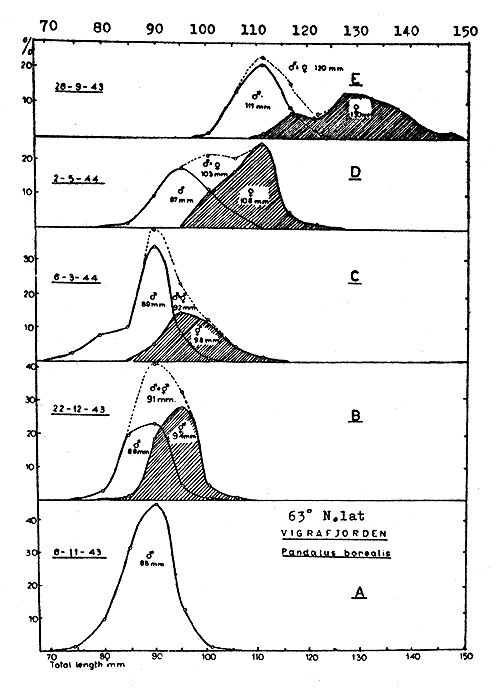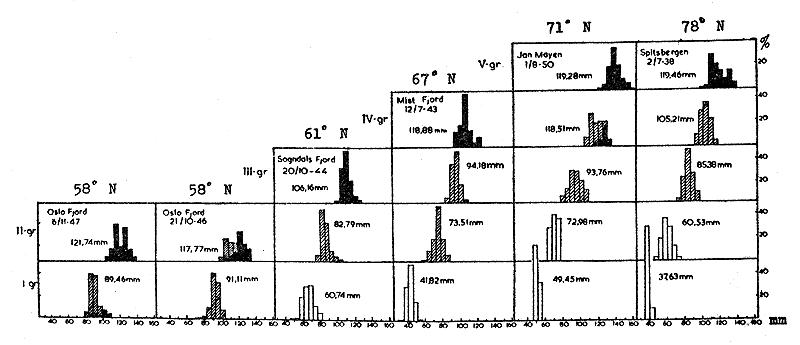by
BIRGER RASMUSSEN
Institute of Marine Research, Bergen, Norway
Abstract
The deep-sea prawn (Pandalus borealis) is a boreal species, whose European distribution extends from the Arctic Ocean to the northern North Sea. The species exhibits protandric hermaphroditism, i.e., the young are males but later became females. In the North Atlantic the prawns show great variations in growth, age and in sexual maturit In the far north the prawns become mature females when five years old, while in the south when two and a half years old. It appears that sea temperature is the regulatory factor for growth and maturation. A year-class of prawns upon maturity may split into two fractions: one slow-growing and retaining the male sexual characteristics, and the other fast-growing and changing into females. The length frequency distribution of such a divided year-class may show two maxima.
VARIATIONS DANS L'APPARITION DE LA PROTANDRIE CHEZ Pandalus borealis
Résumé
La crevette nordique (Pandalus borealis) est une espèce boréale dont l'aire européenne de répartition s'étend de l'océan Arctique au secteur septentrional de la mer du Nord. Il s'agit d'une espèce protandrique, c'est-à-dire que l'animal, d'abord mâle, devient ensuite femelle. Dans l'Atlantique Nord, de grandes différences apparaissent en ce qui concerne la croissance, l'âge et la maturité sexuelle des crevettes. Dans l'extrême Nord, elles deviennent femelles matures à cinq ans, alors que dans le Sud, elles le deviennent à deux ans et demi. Il semble que la température de la mer soit le facteur déterminant en matière de croissance et de maturation. Arrivee à maturité une classe de crevettes du même âge, peut se diviser en deux fractions: l'une à croissance lente et qui conserve les caractéristiques sexuelles du mâle, l'autre à croissance rapide qui se transforme en femelle. La distribution des fréquences de longueur d'une telle classe peut accuser deux maxima.
VARIACIONES DEL HERMAFRODITISMO PROTANDRICO DE Pandalus borealis
Extracto
El camarón Pandalus borealis es una especie boreal cuya distribución europea va desde el Océano Artico hasta la parte septentrional del Mar del Norte. Las especies exhiben hermafroditismo protándrico, es decir, los jóvenes son machos pero más tarde se transforman en hembras. En el norte del Atlántico varían mucho el crecimiento, edad y madurez sexual de los camarones. En el extremo septentrional Pandalus borealis se transforma en hembras maduras a los cinco años de edad, en tanto que en el sur ocurre el fenómeno a los dos años y medio. Parece ser que la temperatura del mar es el factor regulador del crecimiento y la maduración. El camarón de la clase de un año se divide en dos fracciones al alcanzar la madurez: una de crecimiento lento que conserva las características sexuales masculinas y la otra de crecimiento rápido que se transforma en hembra. También puede haber dos máximos en la distribución de frecuencia de tallas de una clase anual así dividida.
The deep-sea prawn is a boreal species with a northern distribution. This crustacean has a life history of a very complex nature. In the nineteen thirties it was discovered to be a protandric hermaphrodite, i.e. each prawn has the ability to change its sex in such a manner that in early life it acts as a male and later it acts as a female. Early investigations further indicated that the growth and sexual maturity of the prawn were largely uniform in all areas of its distribution, as for instance on the Pacific Coast of Canada as well as in the Atlantic, where the prawn stocks off the Scandinavian countries were investigated. The general biological picture was that the deep-sea prawn functioned as an active male when 1½ years of age, at a length of 90 mm, then changed its sex and spawned as a female when 2½ years of age, at a length of 120 mm. Subsequent investigations proved, however, that the growth rate and the sexual development of the deep-sea prawn in Arctic regions was much slower than in any of the areas previously investigated. For instance, in Spitsbergen waters (Lat. 78°N) the prawns did not mature as males till 3 years of age, they remained as functional males in the fourth year and did not reach the female stage till 5 years old. It was natural to pursue the investigations on the deep-sea prawn on the hypothesis that in different latitudes from south to north we might be able to find prawn populations which by their pattern of growth and sexual development would form natural intermediate links between the prawns in the southern and northern area of distribution. Later investigations showed that the cycle of growth and maturity in the deep-sea prawn varied not only from one locality to another, but also from brood to brood born in different years in one and the same locality, which indicated the basic rules for the reaction of the prawns toward changes in the environment.
Decreasing temperatures in the sea will cause slower growth and retard maturing in the deep-sea prawn. This means that in the North Atlantic we will generally find more slow-growing and slow-maturing prawns the farther north we go. In Norway many prawn fields are situated in socalled “threshold fjords”, i.e. deep inlets with a shallow barrier at the entrance. In these fjords we often find lower temperatures and salinities than in the open sea outside. The prawns in these threshold fjords can, without regard to geographic latitude, show a life history approaching that of the slow-growing prawns in Arctic waters.
The spawning of the deep-sea prawn also shows features which seem to conform to a certain pattern. In the southern part of the area of distribution spawning is in October-November, the females carrying their eggs about 5 months till they hatch in the following March-April. However, in the extreme north (Lat. 78°N) spawning takes place 3 months earlier than in the south, and the eggs hatch 2 months later the following spring, the ovigerous period in the Arctic thus lasting for about 9 months. Along the coast of Norway we find intermediate duration of the ovigerous period, 7 to 8 months in northern Norway decreasing to 5 months further south. The general rule seems to be that the colder the environment, the earlier spawning and the longer the ovigerous period.
2.1 Effects of age and size
Generally all individuals of a prawn population in the southern area of distribution spawn as active males at a length of about 90 mm and age 1½ years, and as active females at a length of about 120 mm and age 2½ years. But going progressively northwards the prawns mature as males and females respectively much later in life. In spite of the great difference in age when maturing, the size of males and females respectively is largely the same when spawning. There is obviously an intimate connection between sexual maturity and rate of growth in the different areas. The basic principle seems to be that a particular prawn population, or a single year-class, having a high rate of growth produces sexually mature males and females earlier in life than does a slow-growing population. The number of individuals within an age-group maturing as respectively males and females is determined not so much by the age as by the size attained by the individual prawns. This is illustrated in Fig. 1.

Fig. 1 Group of male prawns (A), the separation of a female fraction (B), and the subsequent growth of both fractions (C.D.E.). (E relates to the previous year-group to that shown in A to D).
A year-class of prawns 1½ years old may show a size distribution as shown in Fig. 1 A, containing prawns 75 to 100 mm in length with a mean length of 88 mm. This size-group of prawns contains active males in late autumn. In Fig. 1 B a division of the age-group has just taken place, one part having attained transitional characters into females, the other part retaining the male characters. The division of the age-group does not occur at a sharply defined size. The male and the transitional fractions form two separate groups which overlap in size. During the subsequent months the two fractions show a steadily increasing difference in mean size caused by the difference in rate of growth (Fig. 1, C,D,E,). In the absence of information on the late growth of this year-group, Fig. 1 E has been compiled from data for the previous year.
The principle governing the mechanism of this division within an age-group seems to be that the largest individuals of the group will change into females, while the smaller prawns remain males. The very smallest individuals of an age-group may even form a third fraction on the extreme left consisting of immature prawns. The division of an age-group into different sex categories is closely connected with the attainment of a more or less definite size level. If for instance an age-group has attained a mean size of about 80 mm in autumn only a few individuals will mature as females. If, however, the mean size attained by the age-group is 100 to 110 mm perhaps 25 to 75 percent become females. Age-groups of a mean size of 120 mm in autumn will generally consist of females only. The lengths stated only indicate the trend of the sexual development.
The general rule seems to be that the largest males of an age-group undergo the transformation into females first. The growth of the transition animals in the following months is accelerated, while those animals which remain males have a restricted growth. As a natural consequence, a single age-group of prawns may come to consist of two distinct size-groups, one of small males and the other of large females; such an example is illustrated in Fig. 1 E. If not closely followed they would normally have been misinterpreted as two different age-groups.
2.2 Effects of latitude and temperature
Environment, rate of growth, and sexual maturing are closely connected factors which find their expression in the varied life histories of Pandalus borealis in the many localities between the Arctic Ocean and more southern areas. The prawn can sustain life and multiply within a wide range of temperatures, submitting to local conditions, growing and maturing in conformity to laws laid down by nature. In temperate surroundings the deep-sea prawn grows fast and matures early, in the cold waters of the far north the prawn grows slowly and matures late in life, while in between we find prawn populations which in their life history show intermediate links between the two extremes. Examples of this extreme pattern of variation is shown in Fig. 2. From one growth type to another we find a natural transition expressed by a varied sexual division within the different age-groups.

Fig. 2 The variations in age, size, and sexual development of the deep-sea prawn in various localities along the Norwegian coast and in Arctic waters. White: young. Shaded: males. Black: females.
The variations in growth and maturity of the deep-sea prawn will naturally influence the productivity and the renewal of the prawn stocks on the different fishing grounds, and thus also have a certain effect on the commercial prawn fishery. In localities where P. borealis has a slow rate of growth the prawns become ovigerous late in life and produce generally only one brood, while in localities where the rate of growth is fast two generations may breed within the same period of time. If a prawn field with a high reproductive ability should be overfished the stock would recuperate in a short space of time, while a locality with a low reproductive rate would need a longer time to become remunerative again.
The practical results of the investigations on the deep-sea prawn indicate that certain prawn fields, particularly in Arctic waters, are unlikely to stand the same fishing intensity as those in southern areas. These biological aspects must be taken into consideration when protective measures are contemplated.